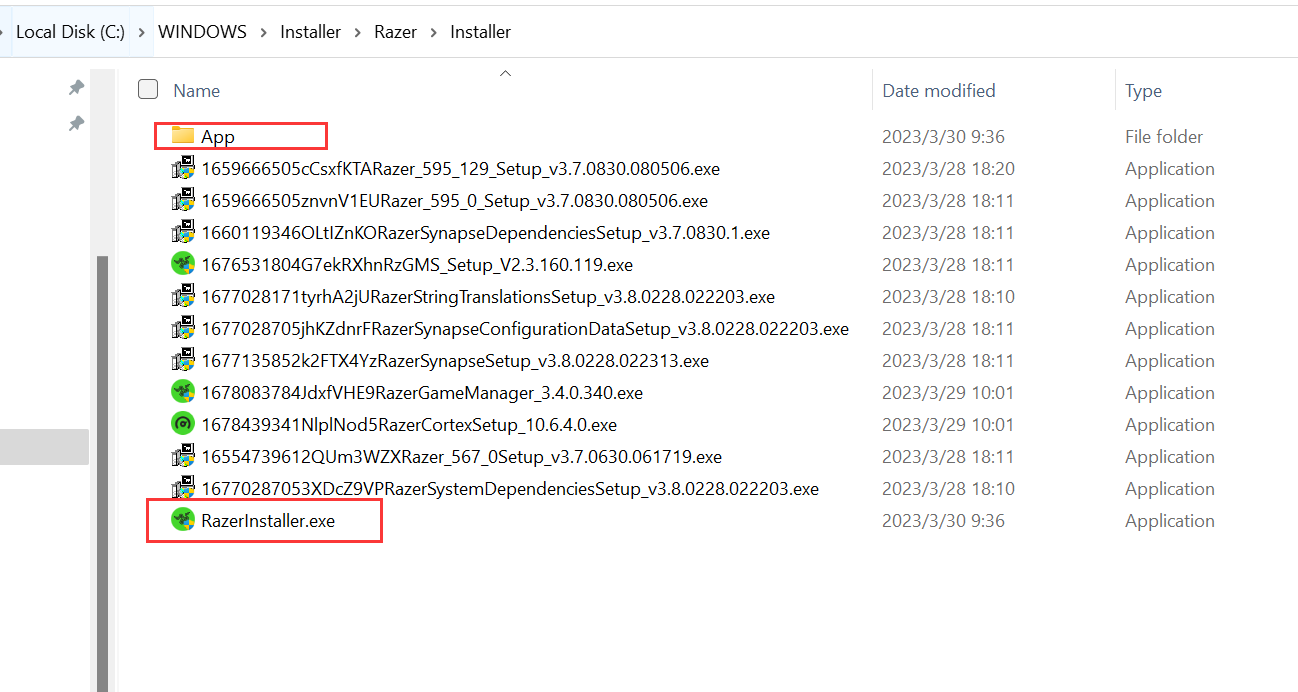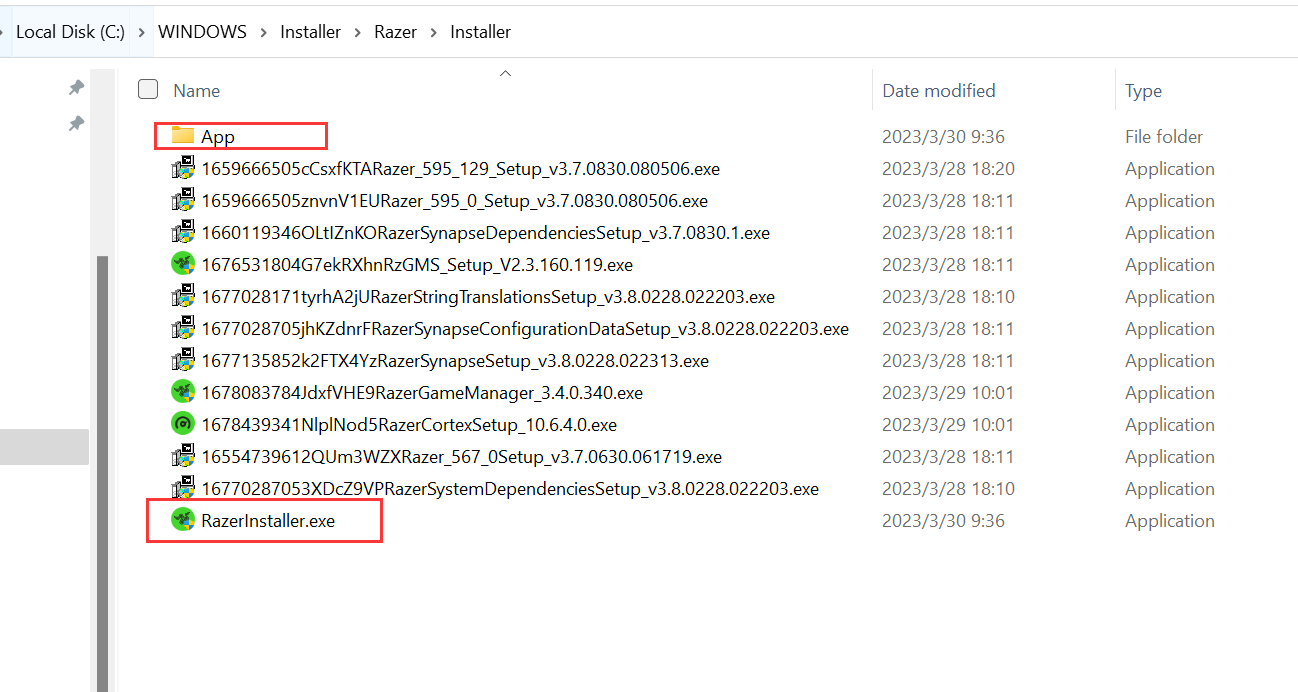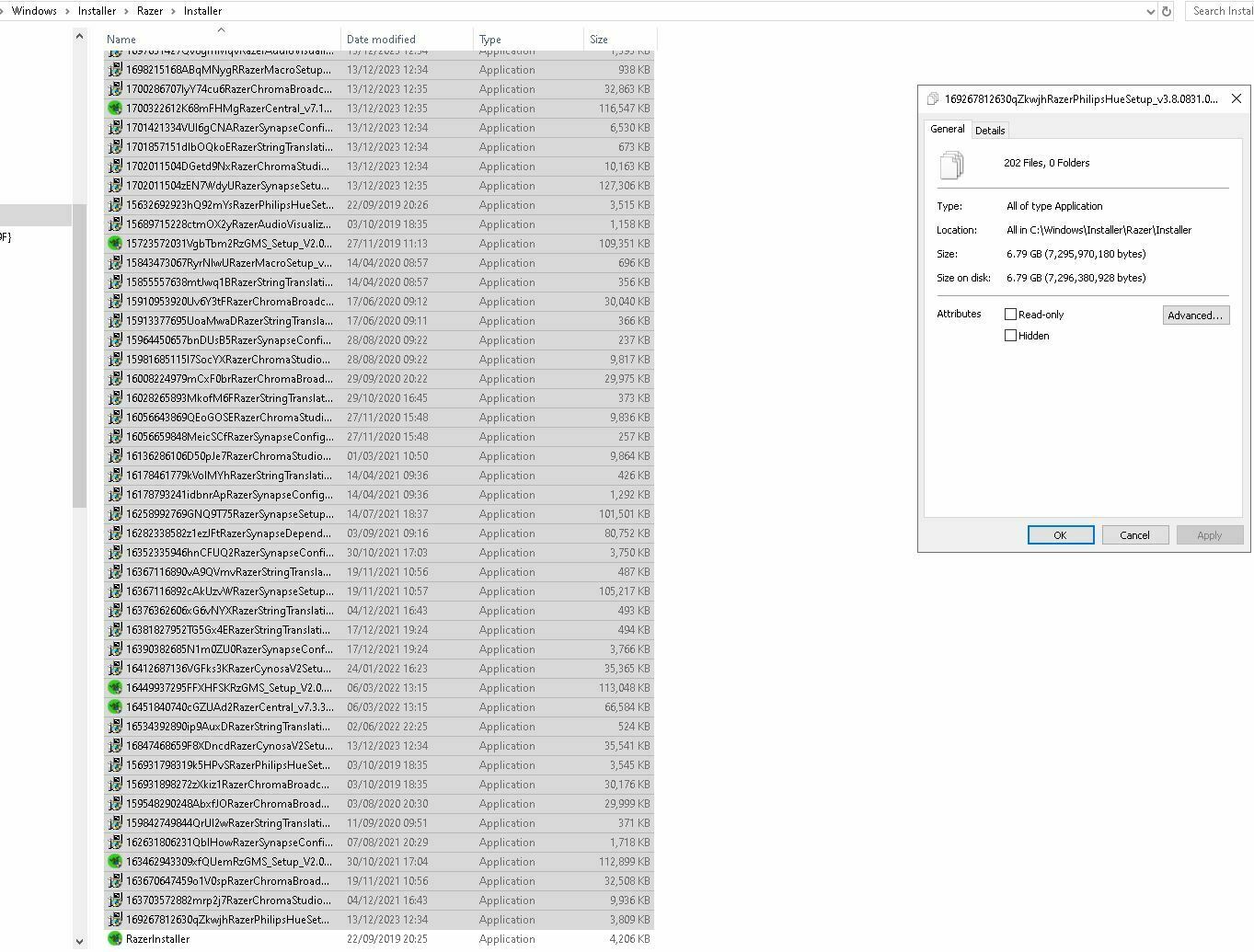My C:\Windows\Installer\Razer? is over 13GB. I’ve read from others that it can be unsafe to delete this. Is there a good way to reclaim this space? Is it actually safe to delete?
Really not understanding how it’s that difficult to include something similar to this PowerShell one-liner at the end of the install. It only took about 45 seconds to write. It’s quite apparent that this is not a priority and has been pushed into the depths of the backlog if a story has indeed ever been created for the development teams. Please feel free to pass this fix along to the teams. They may use it free of charge.
Get-ChildItem -Path "$($env:windir)\Installer\Razer\Installer" | Where-Object -FilterScript { $_.Name -notin @("App","RazerInstaller.exe") } | Remove-ItemOther users…..please note that it must be run from an administrative PowerShell session because it’s trying to manipulate files under the Windows directory. You would normally get an elevation prompt if you attempted to remove the files manually.
Hi
Given the fact that a fix should be trivial, I have the feeling that Razer doesn’t really care about fixing it or they would have already. :-(
8.6 GB (Razer) with a total of 12.2 GB (folder Installer) in my case - I will delete the whole folder and check what will happen.
5 min later: I deleted the whole folder (Razer) without ANY issues after the reboot.
There are some more Razer folders under Installer - I am wondering why a company does not use one folder (Razer) with sub-folders for each of their product (like (/Razer/Synapse, /Razer/Razer Central, /Razer/Razer Game Manager Service). That leaves the impression to me that the company’s developers are working very unstructured/unorganized (or the product owners can be trained a bit)
They just seem to be update-files that Razer's update-method seems to refuse to clean up after itself. - I've also had this issue, having built up tens of Gigs of Razer-files over the span of a few years on the same Windows-installation, and wondering where my drive-space went. - I had to find out with one of those drive-space-analyzers, because these are basically "hidden" files. Or at least they're not in a location you tend to go and see, and they're also not put there with the user's permission.
And, no, removing those files (with the longer names) generally shouldn't cause any issues, because they're basically just update-files that Razer's updater runs, but doesn't remove when there are new ones. - You could leave the newest ones to be safe, as perhaps they might be used or something. But the user shouldn't be expected to manage these files. Razer should program it to clean up after itself if those files are old and won't be used anymore.
This is really bad practice and shouldn't happen. I can't believe this still happens, as I complained about it at least half a year ago and I know it had been noticed back then.
I am sorry to say this but this is just sloppy installation handling. I am trying to figure out space to update to Windows 11 and by using a disk analyzer take a wild guess what took 10 GB of my already limited fast system drive. Please handle this.
They just seem to be update-files that Razer's update-method seems to refuse to clean up after itself. - I've also had this issue, having built up tens of Gigs of Razer-files over the span of a few years on the same Windows-installation, and wondering where my drive-space went. - I had to find out with one of those drive-space-analyzers, because these are basically "hidden" files. Or at least they're not in a location you tend to go and see, and they're also not put there with the user's permission.
And, no, removing those files (with the longer names) generally shouldn't cause any issues, because they're basically just update-files that Razer's updater runs, but doesn't remove when there are new ones. - You could leave the newest ones to be safe, as perhaps they might be used or something. But the user shouldn't be expected to manage these files. Razer should program it to clean up after itself if those files are old and won't be used anymore.
This is really bad practice and shouldn't happen. I can't believe this still happens, as I complained about it at least half a year ago and I know it had been noticed back then.
Thank you for sharing your concerns with us. Our engineering team will resolve it in the future. Thank you for your feedback.
Michelle
They should have resolved it already. Please put this issue on higher priority.
This is basic functionality that should have been there already a long time.
For those struggling with this still. Here is a Windows Task you can schedule to run automatically that will delete everything in that folder that isn’t the App folder or RazerInstaller.exe. Instructions below on how to set up that script.
CAUTION: This script works to do exactly as advertised. If Razer ever changes this folder structure you will need to turn off the schedule or it can / will cause issues.
-
Create the Batch Script:
Open a text editor like Notepad and paste the following code:
@echo off
set "targetDir=C:\Windows\Installer\Razer\Installer"
if not exist "%targetDir%" (
echo Target directory not found.
exit /b 1
)
echo Deleting files in %targetDir%...
for %%I in ("%targetDir%\*") do (
if /i not "%%~nI"=="App" if /i not "%%~nxI"=="RazerInstaller.exe" (
del "%%I" /q
)
)
echo Cleanup complete.Save the file with a .bat extension, such as RazerCleanupScript.bat.
-
Test the Batch Script:
Before scheduling the task, test the batch script by double-clicking it to ensure it deletes the correct files.
-
Schedule the Task:
Now, let's schedule this batch script to run monthly using the Task Scheduler:
- Open Task Scheduler (search for "Task Scheduler" in the Start menu).
- In the right-hand Actions pane, click on "Create Basic Task..." to open the wizard.
- Follow the wizard to set a name for the task (e.g., "Monthly Cleanup Task") and a description.
- Choose "Monthly" as the trigger, set the desired monthly recurrence pattern, and proceed.
- Select "Start a program" as the action, then browse and select your batch script (RazerCleanupScript.bat.).
- Complete the wizard by reviewing your settings and clicking "Finish."
-
Additional Considerations:
- Permissions: Ensure that the account under which the task will run has sufficient permissions to delete files in the specified directory.
- Logging: Consider adding logging to your batch script (
>> logfile.txt) to capture any errors or status messages during execution.
They just seem to be update-files that Razer's update-method seems to refuse to clean up after itself. - I've also had this issue, having built up tens of Gigs of Razer-files over the span of a few years on the same Windows-installation, and wondering where my drive-space went. - I had to find out with one of those drive-space-analyzers, because these are basically "hidden" files. Or at least they're not in a location you tend to go and see, and they're also not put there with the user's permission.
And, no, removing those files (with the longer names) generally shouldn't cause any issues, because they're basically just update-files that Razer's updater runs, but doesn't remove when there are new ones. - You could leave the newest ones to be safe, as perhaps they might be used or something. But the user shouldn't be expected to manage these files. Razer should program it to clean up after itself if those files are old and won't be used anymore.
This is really bad practice and shouldn't happen. I can't believe this still happens, as I complained about it at least half a year ago and I know it had been noticed back then.
Thank you for sharing your concerns with us. Our engineering team will resolve it in the future. Thank you for your feedback.
Michelle
Hey there!
Thank you for sharing your issue with us here. My name is Michelle from the Razer Cortex technical support team. I am deligted to be of your assistahnce.
We sincerely apologize for the inconvenience this issue has caused you. Please kepp the “App‘ folder and “RazerInstaller.exe”, delete all other files. Please check the screenshot below:

Please let us know whether it helps. Thank you for your patience.
Michelle
Hi
We deeply regret the inconvenience caused by the issue you have encountered. Please accept our sincere apologies for any disruptions you may have experienced. We want to assure you that we are actively working on resolving this problem in the upcoming major release of Razer Central.
In the meantime, we kindly request your assistance in addressing the issue on your end. To do so, please manually delete the files mentioned above.
Once again, we apologize for any difficulties you have faced. We value your patience and understanding as we strive to provide you with an improved user experience.
If you have any further questions or concerns, please don't hesitate to reach out to our support team. We are here to assist you.
Thank you for your cooperation.
Michelle
You still did not fix it. Such a shame lads.
Really not understanding how it’s that difficult to include something similar to this PowerShell one-liner at the end of the install. It only took about 45 seconds to write. It’s quite apparent that this is not a priority and has been pushed into the depths of the backlog if a story has indeed ever been created for the development teams. Please feel free to pass this fix along to the teams. They may use it free of charge.
Get-ChildItem -Path "$($env:windir)\Installer\Razer\Installer" | Where-Object -FilterScript { $_.Name -notin @("App","RazerInstaller.exe") } | Remove-ItemOther users…..please note that it must be run from an administrative PowerShell session because it’s trying to manipulate files under the Windows directory. You would normally get an elevation prompt if you attempted to remove the files manually.
This another example of extremely simple solution and Razer seem to complete ignore anything happening in this thread. Please, make this a priority as I had to AGAIN clean up 10 GB of your crappy leftover install files. This is not a MINOR ISSUE whatsoever > this is bad installer code in its finest and needed to be addressed when reported EIGHT MONTHS AGO. The fact that it still isn't shows that you are either completely incompetent or do not take this seriously.
8.6 GB (Razer) with a total of 12.2 GB (folder Installer) in my case - I will delete the whole folder and check what will happen.
Please keep the below folder and installer marked as below, and delete all others.

Michelle
8.6 GB (Razer) with a total of 12.2 GB (folder Installer) in my case - I will delete the whole folder and check what will happen.
Please keep the below folder and installer marked as below, and delete all others.

Michelle
Allready deleted everything. And it is still working. To be honest: Every byte stored without the need wastes energy - 8 G times a 100 million Razer users equals about a 800 Petabyte (lets say 1 Exabyte). I will not calculate the energy consumption, but it will be a mass.
Razer should care better about our environment.
1 year after the original post and it is still happening the same.
I had 13 GB on my C:\Windows\Razer\Installer folder
That is very sloppy programming. Could you fix that already? Please.
There’s another folder C:\Windows\Installer\Razer Central which take lots of spaces. Which files in this folder can I delete to free the storage?
You can delete all files in that folder. We want to assure you that we are actively working on resolving this problem in the upcoming major release of Razer Central. Sorry for the inconvenience.
Michelle
This still isn’t resolved, and if it was (doubt it), it didn’t clean out the old crap.
I also had this same issue, my SSD had around 10gb in this folder and a good friend of mine cleaned 8gb from hers.
A crying shame that this is the new norm for companies; promise a fix then fail to deliver in months, sometimes even years.
still a problem after all this time  this company just doesn’t seem to care anymore, or if they do, hire new engineers because this is easily fixable in less than 20 minutes.
this company just doesn’t seem to care anymore, or if they do, hire new engineers because this is easily fixable in less than 20 minutes.
Really not understanding how it’s that difficult to include something similar to this PowerShell one-liner at the end of the install. It only took about 45 seconds to write. It’s quite apparent that this is not a priority and has been pushed into the depths of the backlog if a story has indeed ever been created for the development teams. Please feel free to pass this fix along to the teams. They may use it free of charge.
Get-ChildItem -Path "$($env:windir)\Installer\Razer\Installer" | Where-Object -FilterScript { $_.Name -notin @("App","RazerInstaller.exe") } | Remove-ItemOther users…..please note that it must be run from an administrative PowerShell session because it’s trying to manipulate files under the Windows directory. You would normally get an elevation prompt if you attempted to remove the files manually.
Thanks for the script, 6.79 GB saved.

Just deleted every update file for the last 4+ years.
I like Razer products but damn the software leaves something to be desired.
I shouldn’t even remember it exists
There’s another folder C:\Windows\Installer\Razer Central which take lots of spaces. Which files in this folder can I delete to free the storage?
Really not understanding how it’s that difficult to include something similar to this PowerShell one-liner at the end of the install. It only took about 45 seconds to write. It’s quite apparent that this is not a priority and has been pushed into the depths of the backlog if a story has indeed ever been created for the development teams. Please feel free to pass this fix along to the teams. They may use it free of charge.
Get-ChildItem -Path "$($env:windir)\Installer\Razer\Installer" | Where-Object -FilterScript { $_.Name -notin @("App","RazerInstaller.exe") } | Remove-ItemOther users…..please note that it must be run from an administrative PowerShell session because it’s trying to manipulate files under the Windows directory. You would normally get an elevation prompt if you attempted to remove the files manually.
Thanks for the script, 6.79 GB saved.

Well noted. Will let our engineering team know.
Again apologize for the inconvenience.
Thank you!
Michelle
Really not understanding how it’s that difficult to include something similar to this PowerShell one-liner at the end of the install. It only took about 45 seconds to write. It’s quite apparent that this is not a priority and has been pushed into the depths of the backlog if a story has indeed ever been created for the development teams. Please feel free to pass this fix along to the teams. They may use it free of charge.
Get-ChildItem -Path "$($env:windir)\Installer\Razer\Installer" | Where-Object -FilterScript { $_.Name -notin @("App","RazerInstaller.exe") } | Remove-ItemOther users…..please note that it must be run from an administrative PowerShell session because it’s trying to manipulate files under the Windows directory. You would normally get an elevation prompt if you attempted to remove the files manually.
Thanks for the script, 6.79 GB saved.

Well noted. Will let our engineering team know.
Again apologize for the inconvenience.
Thank you!
Michelle
Hey there!
Well noted. We will send this to our engineering team. Thank you for being patient.
Apologize for the inconvenience.
Michelle
They just seem to be update-files that Razer's update-method seems to refuse to clean up after itself. - I've also had this issue, having built up tens of Gigs of Razer-files over the span of a few years on the same Windows-installation, and wondering where my drive-space went. - I had to find out with one of those drive-space-analyzers, because these are basically "hidden" files. Or at least they're not in a location you tend to go and see, and they're also not put there with the user's permission.
And, no, removing those files (with the longer names) generally shouldn't cause any issues, because they're basically just update-files that Razer's updater runs, but doesn't remove when there are new ones. - You could leave the newest ones to be safe, as perhaps they might be used or something. But the user shouldn't be expected to manage these files. Razer should program it to clean up after itself if those files are old and won't be used anymore.
This is really bad practice and shouldn't happen. I can't believe this still happens, as I complained about it at least half a year ago and I know it had been noticed back then.
Thank you for sharing your concerns with us. Our engineering team will resolve it in the future. Thank you for your feedback.
Michelle
this is blatantly false, i just had to install and use WinDirStat to find out that razr was taking up 33GB of storage in the install folder cause your programmers are too lazy to write a script to clean up old updates, fix this.
Reply
Sign up
Already have an account? Login
Log in with Razer ID to create new threads and earn badges.
LOG INEnter your E-mail address. We'll send you an e-mail with instructions to reset your password.
